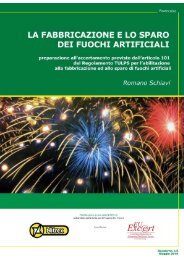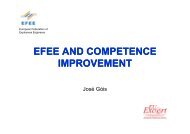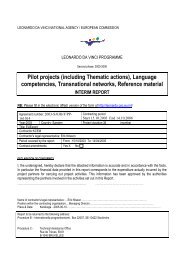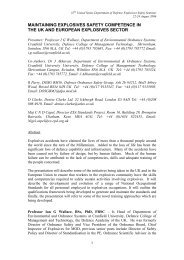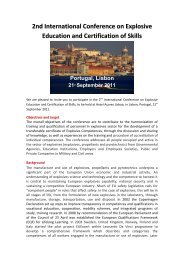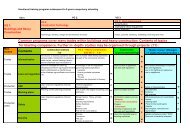Contents of Annexes Annex 1 List of Partners in EUEXcert Annex 2 ...
Contents of Annexes Annex 1 List of Partners in EUEXcert Annex 2 ...
Contents of Annexes Annex 1 List of Partners in EUEXcert Annex 2 ...
Create successful ePaper yourself
Turn your PDF publications into a flip-book with our unique Google optimized e-Paper software.
Figure 1. Examples <strong>of</strong> key role 1 and key role 11 and their subsidiaries<br />
2.3 Competencies<br />
From the functional map the competencies for<br />
each outcome is written, an example <strong>of</strong> a<br />
competency for key role 1.1.1 (Create<br />
specification for ESA) is presented <strong>in</strong> Figure 2.<br />
From Figure 2 it can be seen that the criteria<br />
describes the actual work the employee does <strong>in</strong><br />
undertak<strong>in</strong>g to create a specification, and the<br />
knowledge underp<strong>in</strong>s the activity.<br />
The worker should be able to carry out this<br />
activity <strong>in</strong> all the contexts listed <strong>in</strong> Figure 2.<br />
Another example <strong>of</strong> a competence is presented <strong>in</strong><br />
Figure 3. The competence is for key role 11.1,<br />
‘assess the explosives substances and articles for<br />
disposal’. The total number <strong>of</strong> competencies that<br />
have either been written or taken from exist<strong>in</strong>g<br />
competencies for explosives substances and<br />
articles occupations is 396. In order to assess the<br />
competencies and their relevance to the explosive<br />
worker, they will be assessed by means <strong>of</strong><br />
validation trials. These trials will be carried out<br />
dur<strong>in</strong>g April 2005. Details and venues <strong>of</strong> the trials<br />
<strong>in</strong> the U.K. are presented <strong>in</strong> Table 4. The results <strong>of</strong><br />
the trials will be fed back <strong>in</strong>to the competencies<br />
and the competencies revised accord<strong>in</strong>gly.<br />
Validation trials <strong>of</strong> some <strong>of</strong> the competencies will<br />
be carried out by the European members <strong>of</strong> the<br />
partner countries who are tak<strong>in</strong>g part <strong>in</strong> the<br />
Leonardo da V<strong>in</strong>ci pilot programme. Details <strong>of</strong> the<br />
European trials are also given <strong>in</strong> Table 4.<br />
3. QUALIFICATIONS AND<br />
ACCREDITATION<br />
To demonstrate competence there is <strong>in</strong>creas<strong>in</strong>gly a<br />
requirement to demonstrate that workers possess a<br />
qualification or other <strong>in</strong>dependently assessed level<br />
<strong>of</strong> atta<strong>in</strong>ment. In the U.K. there is currently a<br />
major <strong>in</strong>itiative to rationalise the complex and<br />
confus<strong>in</strong>g range <strong>of</strong> qualifications. The new<br />
National Qualifications Framework shown <strong>in</strong><br />
Figure 4 has been developed, which aligns<br />
vocational qualifications and higher education<br />
awards. Unlike the previous version, it does not<br />
dist<strong>in</strong>guish between general, vocationally related<br />
and occupational qualifications preferr<strong>in</strong>g a<br />
cont<strong>in</strong>uum approach. Nevertheless, universities<br />
and higher education establishments will cont<strong>in</strong>ue<br />
to <strong>of</strong>fer more general qualifications, whilst<br />
employers will be more focussed on occupational<br />
qualifications that are more closely related to a<br />
workers ability to do a specific job.<br />
52



